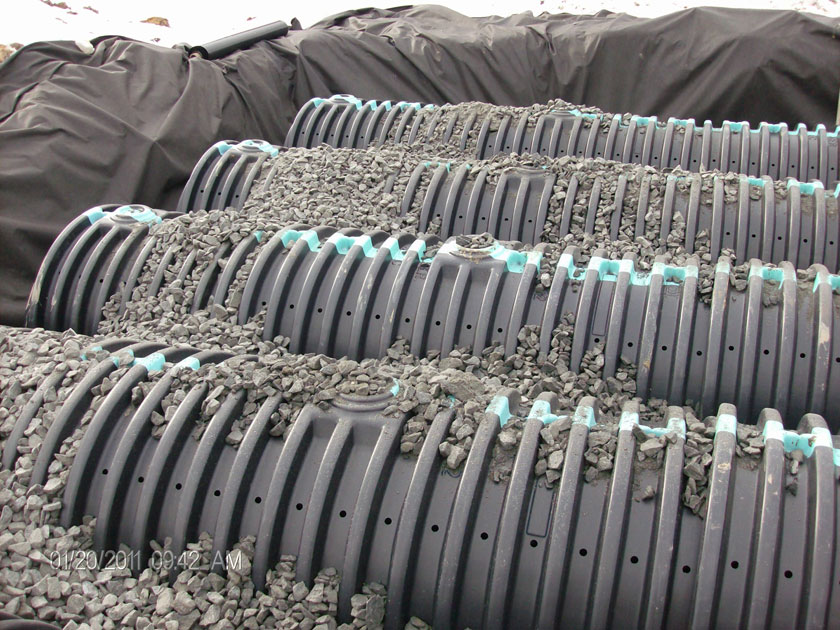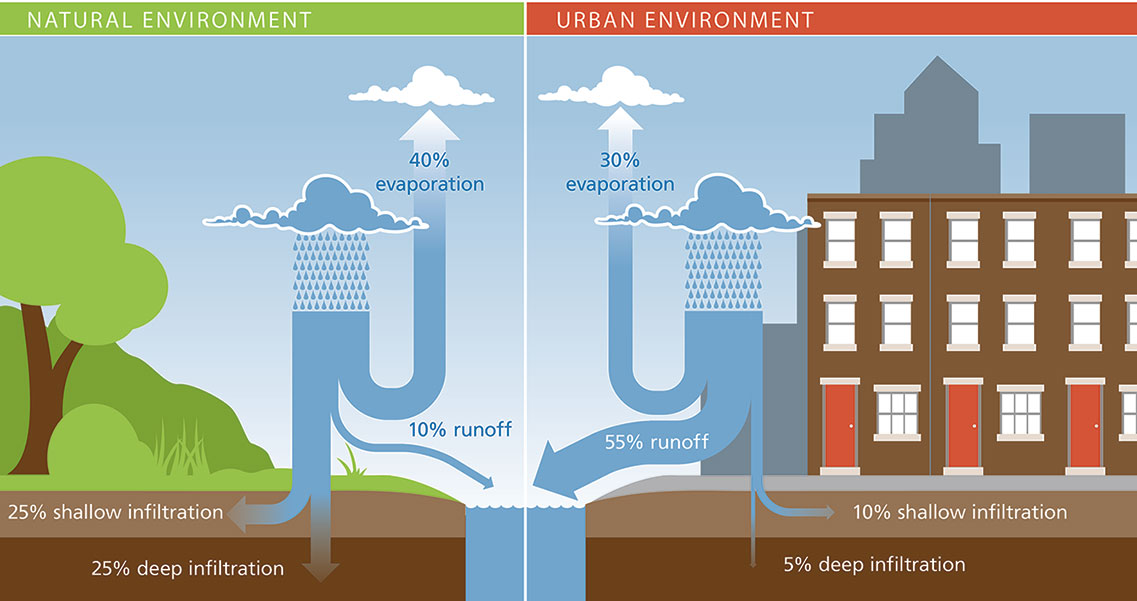The Philadelphia Stormwater Management Guidance Manual (the Manual, or SMGM) is a comprehensive resource for complying with the Philadelphia Water Department (PWD) Stormwater Regulations (Stormwater Regulations), criteria for Stormwater Retrofits, and designing stormwater management on private property to improve the health and vitality of Philadelphia’s waterways along with the City’s own sizable clean water investments.
At its core, the Manual provides detailed guidance for the applicant on how to quickly and efficiently comply with the Stormwater Regulations or meet PWD design criteria for Development, Stormwater Retrofits, and other construction projects. Using this Manual, the applicant will be able to do the following:
- Determine if a project is regulated under the Stormwater Regulations and, if so, what specific requirements need to be met;
- Learn about new ways to incorporate green approaches to stormwater management that provide benefits for Development and Stormwater Retrofit projects and expedite the stormwater approval process;
- Design specific stormwater management practices (SMPs) to meet PWD’s standards;
- Prepare and submit application materials;
- Learn how to ensure proper installation and protection of SMPs during construction activity; and
- Obtain information on post-construction and operations and maintenance (O&M) requirements.
Furthermore, PWD acknowledges that climate change is here, and responsible stormwater management plays an important role in increasing Philadelphia’s resilience. The climate-related impacts Philadelphia is already facing will only continue to grow over this century. Our City will experience more frequent and intense rainfall events, more extreme storms, higher air temperatures, rising sea levels, and possibly increased drought. Therefore, compliance with PWD’s Stormwater Regulations is not only a requirement but is also the responsible strategy to pursue for the sake of our region’s future environmental resiliency and sustainability.
Manual Organization and Purpose
The Manual provides the development community with detailed guidance on designing stormwater management systems to meet the Stormwater Regulations, understanding PWD’s stormwater-related requirements and approval processes, and preparing submissions to PWD. The Manual also provides guidance on topics relating to the proper construction and maintenance of SMPs.
The Manual has six Chapters and a series of Appendices. Chapters 1 through 4 focus on the stormwater design, submittal, and approval process, while Chapters 5 and 6 discuss construction and post-construction topics. As design, submittal, and review processes are closely related, the applicant will find cross-referencing throughout the Manual, particularly between Chapters 2 and 3. The applicant should use each Chapter as follows:
Table 1: How to Use the Chapters in this Manual
| Chapter | How to Use |
|---|---|
| Chapter 1 – Stormwater Management Requirements | Learn about the Stormwater Regulations and Stormwater Retrofits, determine if a project is subject to the Stormwater Regulations, and find out which requirements need to be met |
| Chapter 2 – Submission, Review, and Approval Procedures | Understand the submission and review process for a project and get detailed guidance in preparing submissions to PWD |
| Chapter 3 – Site Design and Stormwater Management Integration | Learn how to perform site assessments, including infiltration testing, and design stormwater management controls, including disconnected impervious cover and SMPs, to comply with the Stormwater Regulations |
| Chapter 4 – Stormwater Management Practice Guidance | Obtain guidance on use, applicability, components, design requirements, materials specifications, construction sequencing, and O&M of specific SMPs, as well as pretreatment, inlet and outlet control systems, and landscaping that support SMP functions |
| Chapter 5 – Construction Guidance | Understand PWD’s construction inspection process, identify common problems with SMP and Erosion and Sediment Control (E&S) construction, and prepare a Construction Certification Package and Record Drawings |
| Chapter 6 – Post‑Construction and Operations and Maintenance Guidance | Understand PWD’s SMP maintenance requirements, learn how to inspect, operate, and maintain SMPs and other stormwater controls, get detailed guidance on O&M Agreements, and apply for stormwater credits |
The Appendices contain additional resources, including, but not limited to, watershed maps, submission checklists, a sample SMP Maintenance Guide, Infiltration Testing Logs, plant lists, Construction Certification Package templates, a sample Record Drawing, and Standard Details. A list of Appendices is provided in the Manual table of contents.
Stormwater Regulations
PWD requires that many development sites in the City implement stormwater management controls. The Stormwater Regulations (Appendix C) define the specific requirements that need to be met for various types of development in the City. PWD’s Stormwater Regulations fall into two categories, Post‑Construction Stormwater Management (PCSM) Requirements and an E&S Requirement.
PCSM Requirements regulate how stormwater runoff leaves a project site in the built, or post-development, condition.
There are four PCSM Requirements:
- Water Quality, to recharge the groundwater table and reduce pollution in stormwater runoff;
- Channel Protection, to minimize channel erosion resulting from stormwater runoff by controlling the peak flow rates for medium-sized storms;
- Flood Control, to prevent, through peak flow rate control, flooding caused by large storm events that could cause damage to life or property; and
- Public Health and Safety Release Rate, to minimize the impact of flooding in areas of the City with infrastructure capacity restrictions through peak flow rate control.
The E&S Requirement stipulates that practices be employed during construction to reduce any erosion and sedimentation that occur as a result of development activities.
Development Services
PWD strives to support development projects through transparent requirements and streamlined processes, to ensure compliance and protection of our city’s infrastructure and water resources. Multiple PWD programs provide review and inspection services for building developments or other projects proposing connections to PWD’s water or sewer system. For any questions regarding PWD’s development review process, applicants are encouraged to email pwd_devservices@phila.gov, call 215-685-0798, or visit the Development Services website.
In addition, in 2021, PWD consolidated several programs to form the Development Services Unit (DSU) and create a consistent point of contact for the development community. Among other functions, this Unit is responsible for all PWD stormwater management programs for private property, including Stormwater Plan Review, Stormwater Inspections, Stormwater Enforcement, and Stormwater Billing and Incentives.
Stormwater Plan Review
Stormwater Plan Review is responsible for administering PWD’s Stormwater Regulations through review and approval of Post‑Construction Stormwater Management Plans (PCSMPs) and offers a range of services, including the following:
- Reviewing development plans for compliance;
- Ensuring that SMPs are correctly designed, installed, and maintained in accordance with the Stormwater Regulations;
- Coordinating with other PWD programs involved in the development review process to establish consistency across the Department and ensure required approvals are obtained;
- Acting as PWD’s link to the larger development process in the City, most critically the Zoning and Building Permit process administered by the City of Philadelphia Department of Licenses and Inspections (L&I). The applicant must receive approvals from PWD before a Zoning or Building Permit may be issued;
- Coordinating with other reviewing entities such as the Philadelphia City Planning Commission (PCPC), Philadelphia Streets Department (Streets Department), and the Pennsylvania Department of Environmental Protection (PA DEP), to ensure that consistent information is provided by the applicant to all agencies; and
- Preparing O&M Agreements for every project installing SMPs under the Stormwater Regulations.
Contacting Stormwater Plan Review
PWD encourages the applicant to contact staff throughout the project’s lifecycle, from preliminary planning through O&M. If additional clarity or discussion is required, the applicant can request a pre-application meeting via the Stormwater Plan Review website. Most meetings are conducted virtually, though in-person meetings can be arranged on request. Staff can be reached during normal business hours (8 a.m. to 5 p.m.) at (215) 685-6387 or pwd.planreview@phila.gov. The general phone line and email account are both monitored regularly by staff. Before a reviewer has been assigned to the project, the applicant should use the general email account for all inquiries to ensure an efficient response time.
Stormwater Plan Review Website
The PWD Stormwater Plan Review website provides content separate from that of the Development Services website and is used by both the regulated and voluntary Stormwater Retrofit programs. It contains specialized tools, including the Reg Finder application to identify stormwater regulatory requirements, a Project Dashboard to submit stormwater plans and request pre-application meetings, and a Project Application Status page.
Stormwater Inspections and Stormwater Enforcement
PWD conducts inspections throughout the project lifecycle, during active construction activities as well as post-construction to ensure proper maintenance and long-term functionality of systems. In addition, PWD will take enforcement actions, as necessary, to seek corrective action for violations on the property.
Active Construction:
- Lead a pre-construction meeting on-site at the commencement of construction to discuss the approved plans and necessary closeout documents;
- Inspect for adequate erosion and sediment controls throughout the duration of construction and earth moving activities;
- Verify that SMPs are installed according to the Approved PCSMP;
- Hold final inspection(s) at the close of construction to record information about the project’s as-built conditions, which the applicant must incorporate into a Record Drawing; and
- Take enforcement action to ensure compliance with approved plans during construction.
Post‑Construction:
- Conducting post-construction inspections to ensure the SMPs and associated drainage areas are maintained and continue to function in accordance with the Approved PCSMP and O&M Agreement; and
- Take enforcement action if necessary to ensure compliance with approved plans and ensure long-term maintenance of SMPs and associated drainage areas.
Contacting Stormwater Inspections and Stormwater Enforcement
PWD assigns inspectors and enforcement coordinators to projects depending on district location and other workload factors. As such, the applicant is encouraged to contact the assigned staff member directly. General questions may be referred to Development Services at pwd_devservices@phila.gov or 215-685-0798.
Stormwater Billing and Incentives
The Stormwater Billing and Incentives Program is responsible for assessing and adjusting the Stormwater Management Service Charge (Stormwater Charge) for parcels within the City of Philadelphia, based on the property classification, gross parcel area, and impervious parcel area. Additionally, the program administers credits and incentives programs to eligible property owners to reduce their Stormwater Charge. In total, the program provides the following services:
- Processes Appeals and Credits application forms to adjust Stormwater Charges, accurately reflecting the on-site conditions;
- Reviews and updates gross and impervious area delineations for Philadelphia’s Stormwater Billing parcels, and maintains GIS data displayed on the Stormwater Parcel Viewer;
- Works with the Office of Property Assessment (OPA), the Water Revenue Bureau (WRB), and property owners to adjust Stormwater Charges;
- Analyzes properties for existing conditions that may be favorable for natural stormwater management processes;
- Administers incentive programs, such as the Stormwater Grants Program, that provides funding for voluntary stormwater management throughout Philadelphia;
- Reviews voluntary Stormwater Retrofit plans for compliance with PWD design standards for SMPs;
- Coordinates with other PWD programs involved in the Development Compliance and Stormwater Retrofit Review Path processes to establish consistency across PWD and ensure required approvals are obtained; and
- Coordinates with other reviewing entities, such as PA DEP, to ensure that consistent information is provided by the applicant to all agencies.
Contacting Stormwater Billing and Incentives
PWD encourages stormwater grant applicants to contact staff throughout the project lifecycle, from preliminary planning through O&M. If additional clarity or discussion is required, the applicant is encouraged to request a meeting. Most appointments are conducted virtually, though in-person meetings can be arranged on request. For a more formal pre-application meeting, the applicant is directed to apply for a meeting.
Questions regarding credits and incentive should be directed during normal business hours (8 a.m. to 5 p.m.) to (215) 685- 6070 or pwd.stormwatercredits@phila.gov. The general phone line and email account are monitored regularly by staff. Before a reviewer has been assigned to the project, the applicant should use the general email account for all inquiries to ensure an efficient response time.
Questions regarding accurate parcel billing can be directed during normal business hours (8 a.m. to 5 p.m.) to (215) 685-6244 or pwd.stormwaterappeals@phila.gov.
Stormwater Billing and Incentives Websites
Stormwater Billing and Incentives’ website contains important information for property owners, the development community, stormwater vendors, and customers looking to assess or amend their Stormwater Charge or apply for incentives for voluntary Stormwater Retrofit projects.
The Stormwater Billing website provides details about how stormwater charges are calculated and detailed breakdowns of the parcel and account charges for all parcels in Philadelphia. From this page, customers can look up their individual stormwater charge, find information about filing an appeal, and apply for the Stormwater Customer Assistance Program (CAP).
The Stormwater Incentives website has information on the various programs and incentives that are offered to water customers in Philadelphia. From this page, the applicant can access detailed incentive pages, such as the Stormwater Credits and Stormwater Grants pages.
The Stormwater Credits website includes descriptions of the different types of stormwater credits that are available to non-residential property owners. The page also includes links to resources such as the Parcel Viewer, Credits Explorer, information on Stormwater Connect, forms for applying and renewing credits, and the Stormwater Management Service Charge Credits and Appeals Manual (Credits and Appeals Manual). These resources help the property owner further understand the Stormwater Charge and connect with vendors who can assist with these forms.
The Stormwater Grants website is specifically geared toward property owners looking to apply for a Stormwater Grant, which can offset costs associated with a voluntary Stormwater Retrofit on their property. This website has information about how to apply for a Stormwater Grant, including updates on application deadlines, the Stormwater Grants Application Guide, a link to Stormwater Connect, and additional application resources.
Stormwater Management in Philadelphia
Unmanaged stormwater runoff—rainfall in developed areas that quickly “runs off” of impervious surfaces rather than soaking into the ground—negatively affects the aquatic and streamside habitats of streams and rivers in Philadelphia. These water bodies suffer from a variety of problems, and, as a result, many of Philadelphia’s streams do not support healthy aquatic communities. Similarly, pollution from unmanaged stormwater that reaches the drinking water intakes on the Schuylkill and Delaware Rivers threatens the City’s potable water supply.
In contrast, healthy streams and rivers have lower rates of erosion, plenty of flow during dry periods for fish and aquatic life, high water quality that supports both recreational uses such as swimming and fishing and potable water use, and flood less frequently and less severely. Clean, healthy rivers are a valuable community amenity that attracts residents and enhances the overall quality of life for residents. The goal of healthy, clean rivers in Philadelphia is an ambitious one, but one that PWD and its partners are resolutely working toward.
Stormwater and Land Development
Land development activities, such as the construction of new buildings, roads, driveways, and parking lots, can lead to increased stormwater runoff and pollution. As land is developed, increases in impervious areas (hard surfaces like rooftops, roads, and parking lots) limit the amount of rainfall infiltrating into the ground. Rates of evaporation are also reduced due to a lack of vegetation. Conversely, in “natural,” undeveloped conditions, the majority of rainfall either infiltrates or evaporates back into the air. As rainfall flows across the developed land surfaces, it picks up pollutants, such as sediment, fertilizers, pesticides, bacteria, metals, and oils, and flows directly into streams, rivers, or other bodies of water. Every acre of impervious cover in Philadelphia produces about 1 million gallons of polluted runoff per year, causing sewer overflows, degraded stream habitat, and water quality problems. Climate change only serves to exacerbate these issues as precipitation in the Northeast region of the U.S., including Philadelphia, is projected to become increasingly frequent and intense as warming continues.
Figure 1: Effects of Urbanization on the Hydrologic Cycle
These problems are not unique to Philadelphia. Stormwater regulations are evolving around the country to address these and similar problems. These changing regulations include new approaches to stormwater management, which often require improvements in stormwater quality prior to discharge, reductions in the volume and rate of runoff, and reductions in stormwater-related erosion and sedimentation. Through these regulations, cities and developers are working together to prevent additional pollution and damage to waterways by controlling stormwater. Philadelphia’s Stormwater Regulations ensure that the City has an effective, comprehensive stormwater program that meets State and Federal requirements and is adaptable to a changing regulatory context and a changing climate.
PWD’s Regulatory Context
The City of Philadelphia is required, by a series of State and Federal regulations and mandates, to clean up its waterways. While PWD is investing billions of dollars to implement the bulk of the required upgrades, PWD, through the Stormwater Regulations (Appendix C), also requires the development community to do its part to help manage stormwater. Table 2 provides an overview of the many State and Federal laws that require PWD to work toward cleaning up Philadelphia’s waterways.
Table 2: Summary and Objectives of PWD Regulations
| Regulation | Objectives | How PWD Meets These Objectives |
|---|---|---|
| Clean Water Act (CWA) of 1972 | Restore and maintain the chemical, physical, and biological integrity of the nation’s waterways |
|
| The Safe Drinking Water Act of 1974 | To ensure safe drinking water for the public by establishing standards for water quality |
|
| The Pennsylvania Stormwater Management Act of 1978 | Develop county-based stormwater management plans to ensure that stormwater is managed properly, particularly with regard to flooding |
|
| National Pollutant Discharge Elimination System (NPDES) MS4 Stormwater Regulations | Reduce and eliminate sources of pollution coming from municipally-owned separate sewer systems into the Nation’s water bodies |
|
| CSO Control Policy | Eliminate discharges of untreated wastewater through combined sewer overflows into the nation’s waterbodies |
|
Clean Water Act (CWA): The CWA of 1972 aims to restore and maintain the chemical, physical, and biological integrity of the nation’s waterways. PWD is primarily charged with ensuring CWA compliance in Philadelphia and does so through a variety of activities, such as building and maintaining public stormwater infrastructure, regulating development, implementing municipal pollution prevention best practices, meeting pollutant discharge standards at sewage treatment plants, and monitoring industrial and commercial dischargers.
PWD’s CSO Program Requirements by the Numbers
7,960,000,000,000 fewer gallons of CSO water released.
85% equivalent mass capture of specific pollutants, such as suspended solids and coliform bacteria, which means removing the same amount of pollutants that would be removed if stormwater were to pass through a wastewater treatment plant.
9,564 Greened Acres, each of which represents an acre of impervious cover within the combined sewer service area that has at least the first inch of stormwater runoff managed by stormwater infrastructure.
Combined Sewer Overflow (CSO) Control Policy: Published by the Environmental Protection Agency (EPA) in 1994, this policy established a national approach for controlling CSOs through the NPDES Permit program. CSOs occur when combined sewers (sewers that convey both stormwater and sewage in the same pipe) reach capacity as a result of stormwater runoff entering the pipe network during rain and snowmelt events. When this happens, the PA DEP permits Philadelphia, as is common with other cities containing combined sewer systems, to discharge excess untreated wastewater into nearby waterbodies. Communities with combined sewer systems are required to develop a Long Term Control Plan to outline steps toward full compliance with the CWA. PWD submitted its original Long Term Control Plan in 1997. In 2006, PWD enacted Stormwater Regulations that included requirements to assist the City in addressing CSOs. Then, in June 2011, PWD and PA DEP entered into a Consent Order and Agreement (CO&A), a binding legal agreement that outlines the water quality targets the City needs to meet to reduce CSOs.
Quick Tip
To determine if a project lies within a CSO area of the City, visit the CSOcast site.
PWD prepared and submitted to PA DEP a LTCPU known as Green City, Clean Waters, to outline specific steps needed to implement the provisions of the CO&A. Green City, Clean Waters outlines a 25-year, $2.4 billion plan to protect and enhance Philadelphia’s combined sewer watersheds by managing stormwater with innovative green stormwater infrastructure. PWD’s approach differs from the methods used by other cities to address CSOs, which typically involve building large, underground tunnels and storage tanks to temporarily hold combined sewer water so that it can eventually be treated by wastewater plants. In Philadelphia, this approach was found to be cost prohibitive for residents; it also did not meet restoration goals for the City’s waterways.
Applicability and Submission Process
PWD’s Stormwater Regulations cover a wide spectrum of development projects. Under the Stormwater Regulations, not all projects are subject to the same requirements. Some projects may need to meet multiple requirements, while others may be subject to only certain portions of the Stormwater Regulations (Figure 2). The application and review process are different for different types of projects, as described below.
Figure 2: Where to Find Further Information on Applications and the Review Process
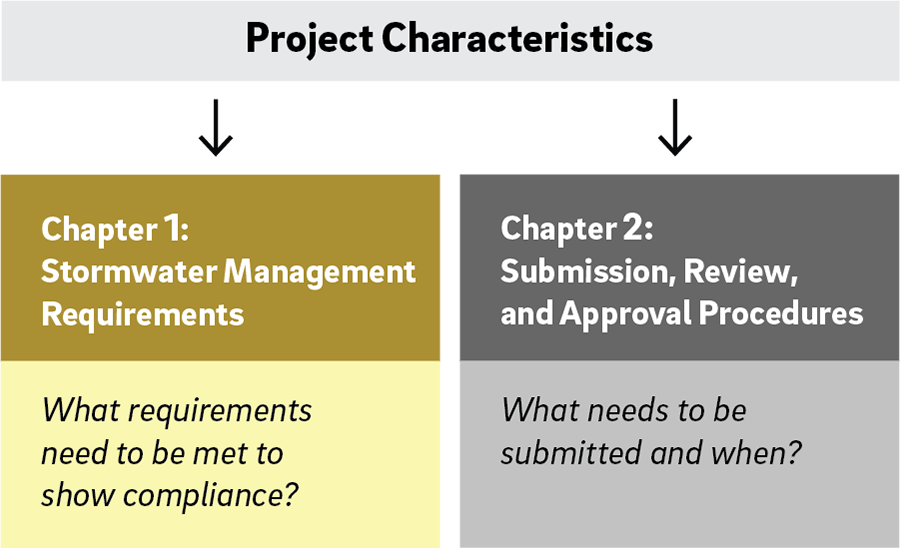
Understanding Applicability
Stormwater Regulations applicability refers to which projects are subject to the Stormwater Regulations, which may not necessarily require on-site stormwater management. The regulatory applicability factors include its development type, its watershed, and the amount of earth disturbance associated with the project. Understanding the Stormwater Regulations’ applicability to a project directly impacts the type of review PWD conducts, which PWD group reviews the project, and the subsequent submission requirements. The applicant should thoroughly review Chapter 1 to understand PWD’s definitions of these factors to determine if the Stormwater Regulations are applicable to a project, and to obtain guidance on how the Stormwater Regulations may be applicable.
Understanding the Submission and Review Process
The final piece of understanding the Stormwater Regulations focuses on preparing submissions and navigating the review process. PWD organizes the different submission procedures and review processes into four Review Paths. Review Paths are a linear series of submission and review steps (Review Phases) taken to obtain stormwater management approval or exemption. There are four Review Paths, which are discussed in greater detail in Section 2.2. Figure 3 provides additional detail on the steps in PWD’s stormwater review and approval process that occur during the design process for the Development Compliance Review Path. These steps are discussed in more detail within Section 2.3.
Figure 3: Stormwater Approval Process for Projects on the Development Compliance Review Path Showing Relationship to Major City Approvals
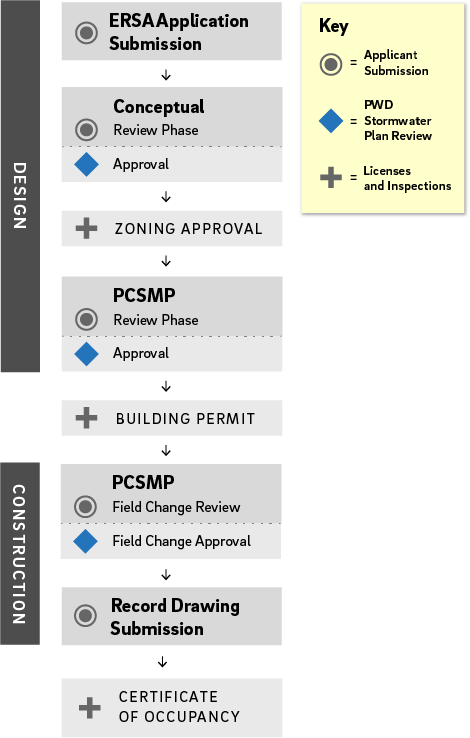
Review Process Timelines and Milestones
It is understandable that the applicant would be interested in how long the review process will take. As with many other aspects of PWD’s program, it depends strongly on the type of project and the associated stormwater management requirements, submissions, and reviews. Upon submission of an Existing Resources and Site Analysis (ERSA) Application and depending on the project’s Review Path, there will be different Review Phases. For the Conceptual Review Phase, PWD strives to review all complete Conceptual Review Phase Submission Packages within five calendar days. For projects undergoing a PCSMP, E&S, PCSMP field change, or Record Drawing review, a review of complete Submission Packages within 15 calendar days is targeted. The fastest way to get a project through the review process is to provide PWD with a high-quality submission that meets all of the submission requirements. Other strategies to streamline the process are to meet with PWD prior to submissions of larger and more complicated projects and to provide as much detail as possible about the project early in the review process.
Projects that fall under the Stormwater Retrofit Review Path, including those that have been awarded a Stormwater Grant with an approved Conceptual Plan in their grant application, may have different timelines. More information on Stormwater Retrofits can be found in Section 1.3, and Sections 2.2.4 and 2.3.4 contain information on the Stormwater Retrofit Review Path and Review Phase, respectively.
Preferred Design Approach
Chapter 3 and Chapter 4 provide detailed guidance to the applicant in designing SMPs that comply with the Stormwater Regulations and PWD design requirements for Stormwater Retrofits. PWD offers the designer a standardized and systematic design process that is consistent for every project. This Section provides a first look at PWD’s preferred approach to stormwater management design.
SMP Design Approach
The SMPs discussed in this Manual incorporate a variety of technologies designed to manage stormwater. While non-structural options, such as reducing the amount of impervious cover and designing for disconnected impervious cover (DIC), are preferred strategies that the designer should consider before proposing SMPs, PWD recognizes that many development projects will need to use SMPs to comply with the Stormwater Regulations. In Chapter 3 and Chapter 4 of the Manual, PWD provides guidance for an array of SMPs that offer design solutions for many different types of sites.
Chapter 4 details nine SMPs, along with pretreatment, inlet and outlet control components, and landscaping. It provides SMP-specific information on applicability and uses, components, design requirements, material specifications, and construction and maintenance guidance.
Infiltration First
When using SMPs to meet PWD’s Water Quality requirement, the applicant must use infiltrating SMPs, which allow water to soak into the ground rather than holding and releasing it. Infiltration is the main focus of the Stormwater Regulations, as these SMPs also filter out pollutants and thus are the most beneficial for improving water quality. Infiltration SMPs must be utilized unless it is demonstrated that they are not feasible due to poor soils, bedrock, soil contamination or other site constraints. PWD requires that the applicant provide documentation of these conditions and request a waiver from the infiltration requirement via the Online Technical Worksheet. Specific requirements for soil and infiltration testing and other related issues are discussed in Section 3.3.
Not All SMPs are Created Equal
To help developers select SMPs, PWD developed a hierarchy that uses ranking factors to prioritize acceptable SMPs. The SMP Hierarchy uses factors important to PWD’s efforts to clean up Philadelphia’s waterways as well as those of primary concern to developers such as ease of maintenance, cost, and impact on buildable area. A full discussion of the SMP Hierarchy is found in Section 3.2.2, but a brief discussion of high, medium, and low-preference SMPs is provided below.
- Highest-preference SMPs are bioinfiltration and bioretention basins, permeable pavers, reinforced turf, and green roofs. Projects required to comply with Stormwater Regulations using only highest-preference SMPs are eligible for an Expedited PCSMP Review (Section 2.4) and may elect to postpone infiltration testing until construction or be exempt from testing.
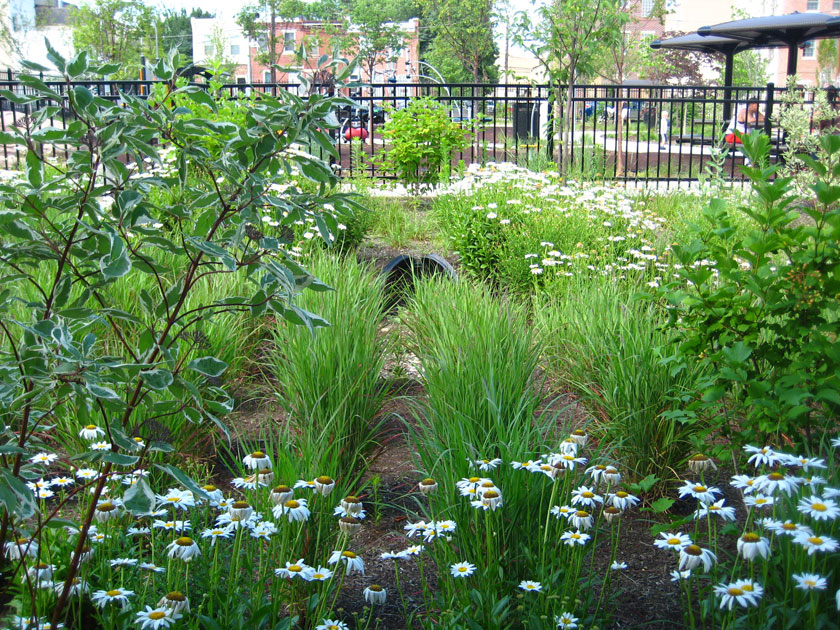
- Medium-preference SMPs (subsurface infiltration, cisterns, blue roofs, porous asphalt, porous concrete, and ponds and wet basins) often provide fewer triple bottom line benefits and may not last as long as more highly-preferred SMPs.
- Lowest-preference SMPs include various types of subsurface detention and media filter systems that are non-infiltrating and provide little-to-no triple bottom line benefits. Lowest-preference SMPs also tend to have relatively high O&M costs and may malfunction more frequently than other SMPs.
